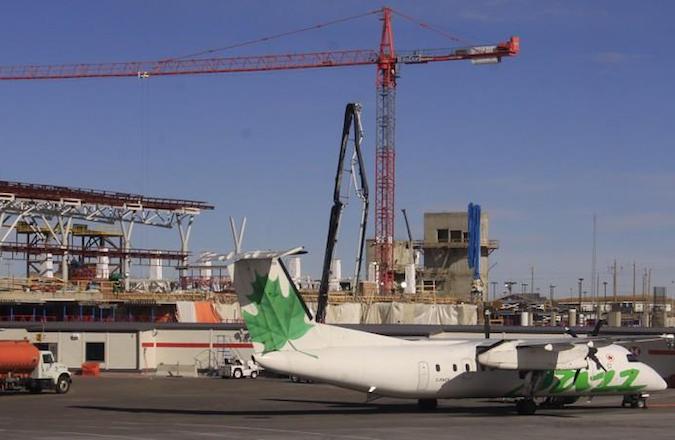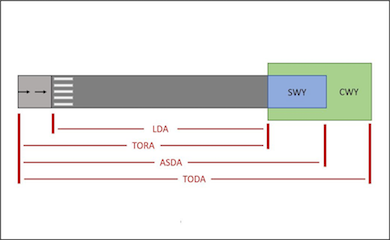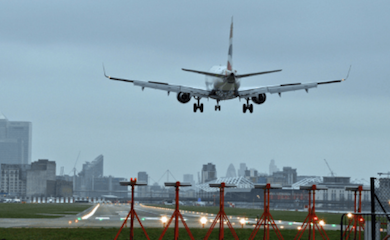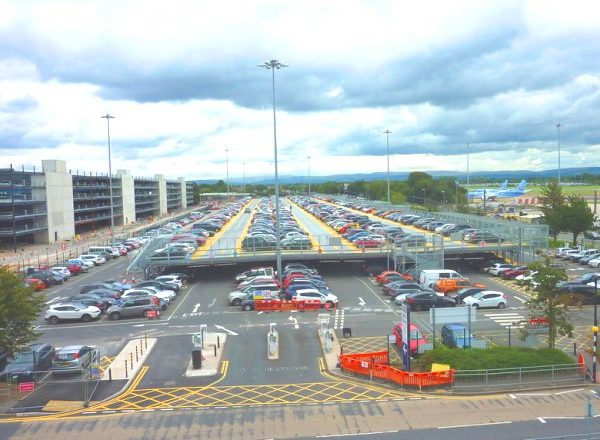Background
Cranes are usually temporary but can adversely affect aviation due to their height. It is therefore often necessary for building developers to prepare a Crane Operation Scheme to ensure cranes will not adversely affect aviation. Crane Operation Schemes are often incorporated into Construction Management Plans.

Technical Height Restrictions
The height of cranes and pile driving equipment may be restricted due to potential impacts on:
- Instrument Landing System (ILS)
- Radar
- Obstacle Limitation Surfaces
- Instrument Flight Procedures (IFPs)
Approval Process
It may be necessary to obtain an approved construction management plan. The plan will include crane locations and heights and may be submitted to the local planning authority who may consult relevant airports or the Ministry of Defence. Final approval usually lies with the planning authority.
Guidance
There are a number of documents that give guidance on the operation of cranes in the vicinity of aerodromes which are referenced in the table below:
| Publisher | Title | Link | |
| 1 | Airport Operators Association | Safeguarding of Aerodromes Advice Note 1 | https://www.aoa.org.uk/wp-content/uploads/ 2016/09/Advice-Note-1- Aerodrome-Safeguarding- An-Overview-2016.pdf |
| 2 | Safeguarding of Aerodromes Advice Note 4 – Cranes and other Operating Issues | https://www.aoa.org.uk/wp-content/uploads /2016/09/Advice-Note-4- Cranes-2016.pdf |
|
| 3 | British Standards | BS 7121-1:2016 Code of practice for safe use of cranes | https://shop.bsigroup.com/ProductDetail/ ?pid=000000000030320608 |
| 4 | Civil Aviation Authority | CAP1096 Guidance to Crane Operators on Aviation Lighting and Notification | http://publicapps.caa.co.uk/docs/33/CAP %201096%20In%20Focus%20- %20Crane%20Ops.pdf |
| 5 | CAP738 Safeguarding of Aerodromes | https://publicapps.caa.co.uk/docs/33/ CAP738Issue02.pdf |
|
| 6 | Construction Plant Hire Association | TIN039 Operating Tower Cranes in the Vicinity of Aerodromes, Notification and En-route Obstacle Lighting | https://www.cpa.uk.net/tower-crane- interest-group-tcig-publications/ |
| 7 | Defence Safety Authority | Manual of Aerodrome Design and Safeguarding (MADS) | https://assets.publishing.service.gov.uk/ government/uploads/system/ uploads/attachment_data/file/575282/ MADS_Issue_8.pdf |
Table 1 Guidance documents relating to crane operations near aerodromes
Documents 2, 4 and 6 contain most relevant guidance.
AOA Advice Note 4
The advice in the AOA, CAA and CPA documents is similar. The AOA document states:
To apply for a permit the following details will be required:
- The exact location of the centre of the crane, as an OS Grid reference (to at least 6 figures for each of eastings and northings), or marked on a map showing the OS Grid;
- The maximum operating height in metres Above Ordnance Datum (AOD), or the height of crane Above Ground Level (AGL) plus ground level in AOD (see Note below);
- The type of crane/equipment (e.g. Tower Crane, Mobile Crane, etc.);
- The radius of the jib/boom of a fixed crane/the area of operation of a mobile crane;
- The intended dates and times of operation;
- Applicant’s name and contact details.
Note: Heights “Above Ordnance Datum (AOD)” are those shown on Ordnance Survey maps
as “Above Mean Sea Level” (AMSL)
…
If the permit is agreed it will set out any appropriate restrictions. A copy of the authorisation permit must remain with the crane for the duration of its operation and must be produced if requested by an aerodrome official or a police officer.
Having been assessed, if the crane (or other tall construction equipment) is considered to be an obstacle to aircraft any of the following may be imposed to ensure the safety of aircraft:
- The fitting of obstacle lights;
- Restrictions on crane operating times;
- Crane operations dependant on the runway(s) in use;
- Restrictions on crane operating height;
- Restrictions during poor visibility (whether caused by fog or low cloud)
- A Notice to Airmen (NOTAM)
Where the design of the crane allows, it should be lowered when not in use, or when
requested by an aerodrome official, such as during periods of low visibility. Where it cannot be lowered, it may be necessary for the jib to be parked in a particular direction when not in use. In some circumstances, the aerodrome may require the type of crane to be used as capable of being lowered.
When it has been determined that aviation warning lighting is required, the characteristics for the light(s) would be specified by the aerodrome operator. Normally, they would be steady red lights of either low intensity (200 candela) or medium intensity (2000 candela), depending on the height of the crane. Lighting should be visible from all directions and located on the highest point of the crane/equipment.
For a tower crane, lighting should be provided on top of the tower and at the end of the jib and should be illuminated at all times. Unserviceable lamps should be replaced as soon as possible after failure and in any event within 24 hours, during this time the aerodrome should be contacted so that a notice (to pilots and air traffic control) can be issued.
…
Upon assessment, where the crane (or other tall construction equipment) is considered
likely to interfere with navigation/communication equipment and/or IFPs the following may be required.
- Restrictions on crane operating times;
- Crane operations dependant on the runway(s) in use;
- Restrictions on crane operating height.
…
For a project close to an aerodrome or under approaches to its runways, it may be necessary for a Construction Management Strategy to be produced by the developer and agreed with the aerodrome to ensure that construction does not prejudice the safe operation of the aerodrome. A Construction Management Plan might be required via a condition on any planning permission that may be granted.
In particular, but not exclusively, the Construction Management Strategy should address the
following issues:
- Use of cranes or other tall construction equipment
- Control of activities likely to produce dust or smoke clouds;
- The design of temporary lighting to avoid distracting pilots (see Advice Note 2 ‘Lighting Near Aerodromes);
- Storage of materials, particularly compliance with height limits;
- Control and disposal of waste, to prevent attraction of birds (see Advice Note 3 Wildlife
- Hazards Around Aerodromes);
- Site management, to prevent attraction of birds through standing water and earthworks
- (see Advice Note 3 Wildlife Hazards around Aerodromes).
Lighting Requirement
For many developments cranes will need to be fitted with 200 Candela steady red low intensity obstacle lighting as set out in the AOA guidance above.
Pager Power
Pager Power can help developers prepare Crane Operations Plans. For more information please contact us on 01787 319001.
Image accreditation: https://images.app.goo.gl/3WGCDykGG4ZXkNWGA
2 Comments
-
It was definitely a worthwhile read. Having a crane operation scheme prevents any issues that might affect aviation so it’s crucial for most companies to follow through with these schemes.
-
Glad you enjoyed it, we are happy to help.
-



